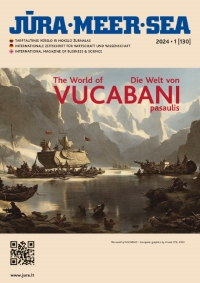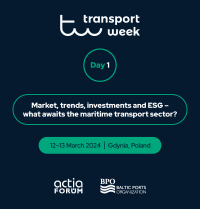28.8 million tonnes of goods were handled in the port city of Rostock last year. This was 200,000 tonnes or nearly one percent more than in the year 2016. This means the highest handling result achieved in the history of the port of Rostock. 26.9 million tonnes of freight passed the edge of the quay at Rostock overseas port alone. According to the port and shipping authority another 1.9 million tonnes were moved at the cargo and fishing port, the chemical port and other port facilities of the Hanseatic city. The number of ferry passengers carried on the lines to Denmark, Sweden and Finland increased by 200,000 to another top score of 2.5 million travellers.
“The port of Rostock is humming with activity, which is good for the city and the region. With this excellent result the ports and companies on either side of river Warnow have impressively demonstrated their high efficiency and competitiveness in 2017”, emphasizes Jens A. Scharner, managing director of ROSTOCK PORT GmbH.
Rostock overseas port
At 26.9 million tonnes (gross) of goods handled in 2017, the companies at Rostock overseas port again achieved a very high handling result after the 26.8 million tonnes in 2016. It is the second best handling result in the almost 60-year history of the all-purpose port. Only 2008 saw more goods passing the ship’s rail, at 27.2 million tonnes.
„Despite a range of challenges and a strongly competitive environment we have managed to repeat the good handling results of previous years and even achieve a small plus. This is all the more remarkable since losses in high-tonnage handling segments were more than compensated for by growth in the ferry and ro-ro traffic. The investments currently under way will create the preconditions for a further growth spurt at Rostock overseas port. In 2018 we will create berths for increasingly larger and longer vessels, for instance, and our partners will build an additional shed for high value-added general cargo. Simultaneously, new grain stores and grain handling facilities are being built, as well as a gigantic heavy-duty crane at Liebherr”, says Dr. Gernot Tesch, managing director of ROSTOCK PORT GmbH.
All told, Rostock overseas port logged 7,752 port calls by ferry and ro-ro vessels, tankers, freighters and cruise liners last year, of which 5,874 port calls alone were made by ferry and ro-ro vessels.
Dry bulk handling was six percent below the level of the previous year with a total of seven million tonnes handled. Especially the wheat export was on the decline due to poor harvests. Compared to 2016, 600,000 tonnes less of wheat were shipped. There were also losses in the handling of cement and CAN (calcium-ammonium nitrate) while the handling of rapeseed showed a very positive trend, increasing to 627,000 tonnes (+60%). Despite the decline in wheat export, grain handling remains the main dry bulk cargo at the overseas port with around 2.8 million tonnes. “A new grain silo and grain loading facility with 160,000 tonnes of silo capacity is under construction on pier 4 and to be completed by the end of 2018. Apart from further enhancing Rostock as a port for grain export the additional loading capacity of 1200 tonnes of grain per hour is particularly significant”, explains Jens A. Scharner.
The handling of liquid goods was on the level of the previous year, at 2.7 million tonnes. More biodiesel, naphtha and gas oil were pumped over the ships’ sides in Rostock last year, but less fuel oil and petrol.
Handling of general cargo went down to 630,000 tonnes. Less slabs and wind power plants passed the edge of the quay. There were increases in the handling of sheet metal and crane facilities.
Wheeled goods traffic increases again
Handling of wheeled cargo, i.e. ferry and ro-ro goods again increased. All told the amount went up by 630,000 tonnes to 16.6 million tonnes (+4 percent on the previous year). The share of wheeled cargo in the total handling of Rostock seaport thus amounted to 62 percent last year.
The number of truck units carried on the ferry and ro-ro connections to and from northern Europe increased from 354,170 in 2016 to 383,373 last year. There was also a slight increase in the number of trailers handled: from 122,352 to 122,680 last year. The number of railway wagons carried to and from Trelleborg by contrast decreased from 20,358 to 14,564. Compared to 2016 the number of cars carried increased by twelve percent to 482,000.
„High growth rates in accompanied truck and car traffic were the highlights of the cargo trend at the overseas port in 2017”, says Dr. Gernot Tesch.
More than two million tonnes of goods were again moved at the Intermodal Transport Terminal in 2017. The number of trailer units handled increased from 69,824 in 2015 and 76,012 in 2016 to 80,288 units and thus by 5.6 percent compared to the previous year. The Intermodal Transport network was continuously intensified and extended. Currently there are 35 block trains operating weekly to and from Verona (14), Hamburg (5), Karlsruhe (5), Halle/Schkopau (2), Brno (6) and Wuppertal (3 times from 23 January 2018 instead of the connection to and from Duisburg operating until then). The trend in intermodal transport was by contrast fair to middling last year especially due to the reduction of departures to Finland as well as due to quality problems in the railway network in the hinterland of Rostock port. The shifting of the Novara train in the second quarter of 2017 and the shutdown of the train to and from Wels once a week at the end of the year therefore had a dampening effect on the amounts carried in intermodal transport while the connections to and from Brno and Verona experienced an increase in frequency. “We continue to work with our partners to intensify individual services and build up new intermodal transport connections. It is all the more heartening that it has been possible to build up a new block train connection for container transports between Rostock and Halle/Schkopau thanks to a strong commitment of, for instance, Stena Line, Deucon and Pressnitztalbahn, which connects Rostock with the Central German Chemical Triangle. This cooperative approach to developing new logistics concepts ought to be expanded”, says Dr. Gernot Tesch.
706,000 tonnes of paper were loaded and unloaded at the overseas port in 2017. The lion's share of the paper handling is provided by UPM. The Finnish paper group concentrated its paper business in the southern Baltic at Rostock in early 2015.
„If we succeed in providing enough areas adjoining water depths suitable for sea-going vessels we will see further logistics and industrial companies settling at the port. Apart from the continuing internal optimization of areas it’s high time to tackle the provision of areas for the coming decades by means of a port extension beyond its present borders”, declares Dr. Gernot Tesch.
205 port calls by 43 vessels expected on 122 days
The 2018 cruise season begins at the Warnemünde cruise port on 8 April with the arrival of the passenger vessel Boudicca of the British Fred Olsen Cruise Lines. „All told we expect 205 port calls by 43 cruise vessels this year. Interest in Baltic Sea cruises continues to increase both in the international and in the national market”, says Jens A. Scharner. 180 times the vessels will berth in Warnemünde and 25 times at the overseas port. Nine vessels will be heading for the mouth of river Warnow for the first time:
Brilliance of the Seas, Britannia, Marella Discovery, MSC Orchestra, Norwegian Breakaway, Sapphire Princess, Seven Seas Navigator, Viking Sun and Zenith. There will be cruise ships calling at the port on river Warnow on 122 days of the year 2018.
Rostock-based shipping company AIDA Cruises will again operate two of its vessels from its Baltic home port of Warnemünde, AIDAdiva and AIDAmar. 43 out of a total of 53 port calls with turnaround of passengers have been notified by AIDA Cruises for 2018. Nine port calls with turnaround of passengers by the vessel Zenith are going to be carried out by the Spanish cruise shipping company Pullmantur at the overseas port and on one occasion the vessel Berlin, operated by FTI, will change its passengers in Warnemünde. Also the Italian shipping companies Costa and MSC Cruises as well as the US-based shipping companies Norwegian Cruise Line and Princess Cruises plan to change some of their passengers here during 57 port calls, with predominantly Italian and German passengers embarking or disembarking.
The sailing list for 2018 includes 39 port calls by very large passenger vessels with a length of more than 300 metres: Britannia and Regal Princess are each 330 metres long, Norwegian Breakaway is 324 metres and Celebrity Silhouette and Celebrity Eclipse are 319 and 317 metres long, respectively. Norwegian Breakaway is the largest vessel of the coming season with a gross register tonnage of 145,655. The Swiss-based shipping company Viking Ocean Cruises has included Warnemünde 24 times in the schedules of its four sister vessels Viking Sea, Viking Sky, Viking Star and Viking Sun.
In the coming year three port calls of the passenger vessel Albatros of Phoenix Reisen have been notified for December so that the 2018 cruise shipping season in Warnemünde will end unusually late.
Projects and investments
“ROSTOCK PORT GmbH invested around 17 million Euro in the infrastructure and the improvement of processes at the port in 2017”, states Jens A. Scharner. As part of measures to improve the traffic flow three partial projects were tackled or completed, respectively: In November 2017 the first construction stage of the new partial motorway junction from the federal motorway to the eastern seaport was begun. The demolition of the old railway signal box near the federal motorway and the new-building of a two-lane elevated road to the port area east of the oil port were both completed in the course of last year.
In order to support the increased traffic flows and handling activities in the ro-ro division the office building in the southern port area was demolished. After the demolition the surface thus created was paved for trailer parking. South of quay shed 7 unused areas of land were levelled and prepared for paving. Around one million Euro were invested in the construction of a new water collector in this area.
At the oil port ROSTOCK PORT invested around four million Euro last year in the renewal of the eastern transverse quay and the jetty facility at berths 3 and 4.
Two sustainability projects of the port operator were implemented: As a statutory compensation measure for infrastructure projects at the port, ROSTOCK PORT has invested in the creation of a park-like area of around 20 hectares east of Werftallee in Gross Klein. The first measures to this end were already begun in 2016. This plot of land is owned by the ROSTOCK PORT and has been improved into a nature experience area.
Furthermore ROSTOCK PORT has completed the renaturalization of the Diedrichshäger Moor (a bog) near Warnemünde in 2017. Merely construction roads and access ways still need to be removed. This measure was approved and granted planning permission in 2009. It will be available to the port as potential compensation in nature protection for future extensions at the existing special-purpose area of the port via an eco-account. The project will progress to the three-year monitoring and maintenance phase in 2018.
After reconditioning the berths 21 and 22 last year, preparations for an EU-wide ITT for the new-building of berth 23 were begun after the successful completion of the notification procedure with the EU Commission in 2016. Already in December 2017 the Hanseatic City of Rostock received confirmation of public subsidies in the amount of Euro 13.5 million from the state government. The 270 m long quay facility at berth 23 to be rebuilt, which is over 50 years old, is located at the eastern side of port basin B and is part of the dry bulk terminal on pier 3. The dry bulk terminal at berths 23 and 24 is predominantly used for the import of hard coal for the nearby power station. “In order to be able to serve larger bulk carriers and thus increase the efficiency of handling operations the water depth at berth 23 must be increased from currently 11.50 to 14.50 metres. Since the existing quay structure is in need of reconditioning and it is impossible for technical reasons to increase the water depth here, we are setting about rebuilding berth 23. Also the load bearing capacity of the area will be increased from two to five tonnes per square meter. Construction is to start in June 2018 and to be completed until the end of 2019”, says Dr. Gernot Tesch. In the area adjoining berth 24 to the north the quay structure is already being prepared for the future extension to 16.50 metres water depth. “The entire project with an investment volume of several million Euro marks the go-ahead for the hydraulics construction at Rostock overseas port geared towards the planned deepening of the navigational channel. The aim is to be able to offer handling services to large bulk carriers immediately after the deepening of the navigational channel planned by the German government”, says Jens A. Scharner.
ROSTOCK PORT plans to spend about 4.5 million Euro on investments in areas and buildings and about 30 million Euro on the renewal of quay facilities this year.
Five large projects are planned to start construction this year: the new-building of berth 23, the upgrading of berth 15 on pier 3 for heavy loads, the new- building or optimization of berths 50 and 62/63 as well as the construction of a new Cruise Center at berth P8 in Warnemünde.
ROSTOCK PORT










